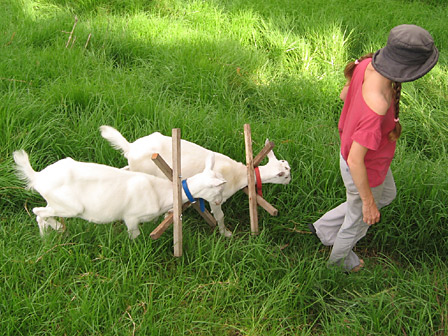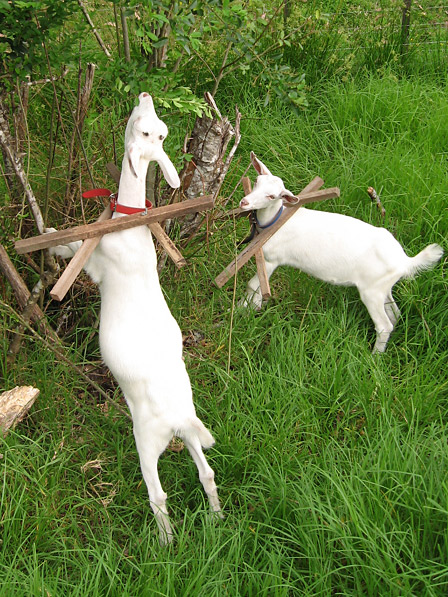Since a while before Christmas, we have been making our own yogurt, butter and cheese here on the Farmlet. With a litre of top quality organic yogurt costing NZ$5.00 and upwards at the supermarket, it makes good economic sense to obtain beautiful creamy milk and make our own yogurt from it. We do not make all our own butter or cheese yet. We make as much butter as we can with the cream skimmed off the top of our six litres per week of creamy Jersey milk. We are getting a lot of satisfaction from doing these things ourselves, and it is good practice for the day when we finally milk our own cows.
 Whole, raw milk (Yes, the container is nearly half full of cream)
Whole, raw milk (Yes, the container is nearly half full of cream)
I’d never made yogurt before, and have been amazed to find how easy it is. This is the method we use:
Heat one quart (one litre) of milk until bubbly but not yet boiling. Take it off the heat and pour it into a shallow container. Cool it until it’s not too hot to hold your finger in it for a few seconds, then stir in a generous tablespoon of yogurt (from your last batch, or a plain commercial yogurt with live cultures). Cover the container, and put it somewhere warm. The aim is to keep it at above body temperature while the cultures grow. We do this by putting it on top of the hot water cylander. It takes about eight hours for the yogurt to set up.
These instructions are not very scientific, but we do end up with tasty yogurt! Experienced yogurt-makers might have better advice than this. Admittedly, out yogurt does not seem to keep as well as the kinds I used buy from the supermarket. Maybe that’s because we are not very careful about regulating the temperature during the process. . . ?
When I was a child, we used to enjoy helping our grandparents make butter out of the cream from their house cow’s milk. They had a big butter churn. Here on the Farmlet, we just put the cream in a jar and shake it until it turns into butter. My grandparents used to have special wooden butter pats for squeezing the buttermilk out of the butter. Kevin and I just rinse it and squeeze it by hand or with a wooden spoon. Butter is one of Kevin’s favourite foods, but he’d never made it before. The first time he saw the golden curds of butter separate from the buttermilk in the jar he was shaking, his face lit up and he let out a yelp of delight. He could hardly believe how easy it was to bring about the magical transformation of cream into butter.
 It is like magic; no, it is magic
It is like magic; no, it is magic
 A lump of creamy goodness is born
A lump of creamy goodness is born
 Pat out the extra buttermilk
Pat out the extra buttermilk
We make a simple (not aged) farmer cheese out of the buttermilk from the butter making, by heating it to almost boiling and curdling it with vinegar (2 tablespoons of vinegar to 1 quart of milk and/or buttermilk).
 Balsamic vinaigrette, tomatoes, basil and lots of soft, white cheese
Balsamic vinaigrette, tomatoes, basil and lots of soft, white cheese
Once it curdles, take it off the heat, and drain it through a strainer lined with cloth. You can add salt to the curds at this stage if you like. This soft white cheese is good in curry, or served with balsamic vinaigrette, tomatoes and basil.










